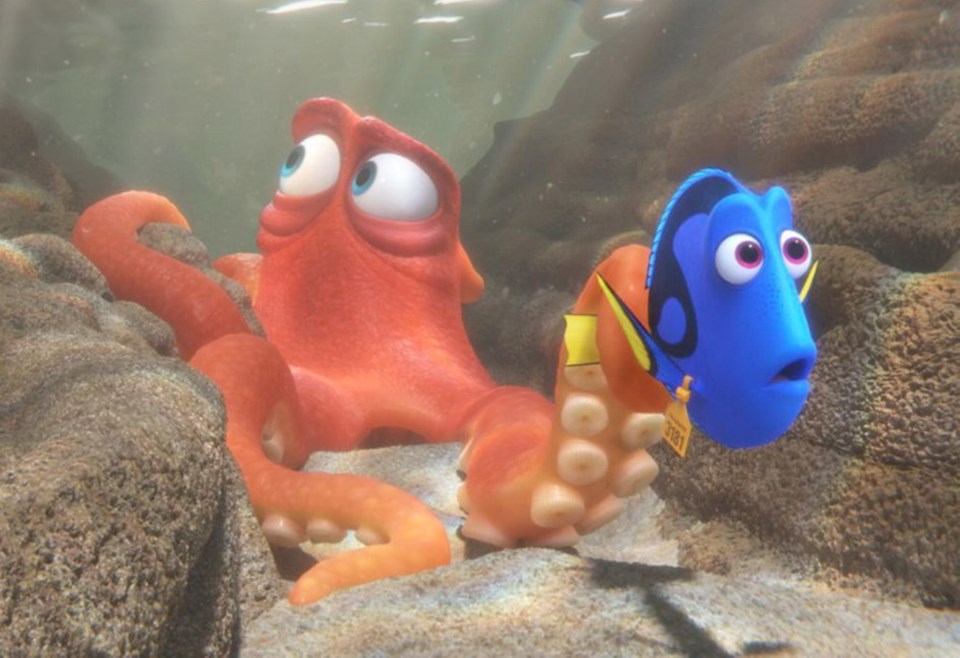When Kristen Lester finally got to watch Finding Dory, she didn’t experience Pixar Animation Studio’s summertime hit the same way most of us did.
“I almost didn’t ‘see’ the movie,” said the Victoria-raised animator, who worked as a story artist on director Andrew Stanton’s sequel to his 2003 hit Finding Nemo.
“It’s such a collaborative process. What I saw were the voices and faces of all the people I worked with on the movie.”
It took her back to a creative process that began almost four years ago, particularly the brainstorming sessions when her team worked with the writers and director to create “a blueprint” for the movie.
“I’d remember when one person said this particular joke, or when another person said: ‘That’s funny, but what about this?’ It ends up being this weird mishmash.”
Comparing it to creating a comic book, Lester said she worked on early drawings and helped write story information pertaining to characters’ personalities to “give a taste of the film before it goes into the rest of the pipeline.”
With such colourful characters, including Nemo, Marlin, beluga whale Bailey and near-sighted whale shark Destiny, the artists had their work cut out for them.
She collaborated on multiple aspects of the story about the blue tang’s quest to find her family.
“I keep telling my dad: ‘Don’t blink!’ ” said Lester, who still can’t believe she got to work with Pixar on the sequel to Finding Nemo, which was released while she was in animation school.
“I remember how I thought it was the greatest movie ever made, and being in the theatre crying. I thought: ‘Omigawd, I so want to work at that place because this is so good.’ So this really is a pinch-me experience.”
Lester’s path to Pixar was strewn with several failed attempts, however. She applied at least seven times, and had her portfolio sent back each time.
“This certainly doesn’t feel like a fluke. I worked really, really hard to get here,” said Lester, who is based in San Francisco. “I had laser-focus watching movies like Nemo and Toy Story. They do it best there, and I wanted to be part of that.”
Contributing factors included determination, hard work, a golden opportunity and good timing, said the former Margaret Jenkins student, who considers herself “lucky” that she always loved to draw.
“I loved animation more than anything. It’s work done with joy,” she said. She said her influences include the late Marc Davis, the Disney animator and designer who worked on characters such as Cinderella, Maleficent and Cruela DeVil and Disney’s theme parks; and Mary Blair, the Disney character designer and concept artist (Alice in Wonderland, Peter Pan).
She was particularly inspired by Bill Peet, the Disney story writer (The Jungle Book, Cinderella) and children’s book author and illustrator whose books her parents read to her growing up.
“I used to copy his drawings,” said Lester, who had planned to major in organic chemistry at the University of Calgary and go to medical school before switching gears and studying animation at Sheridan College instead.
“I laugh now. I was always the kid who said: ‘I want to be a marine biologist — or work with Disney,’ ” she recalled, crediting her mother and a friend with encouraging her to follow her heart.
“Everybody [at Sheridan] had seen the same things I saw, had personalities like mine and they were interested in things I was interested in. I had found my people, where I fit.”
Her first gigs included working in Toronto for Chuck Gammage Animation Inc., as a storyboard artist for TV and direct-to-DVD features for Squeeze Productions, and heading a team of artists as character designer on a reboot of Everyone’s Hero, the computer-animated sports comedy originally directed by the late Christopher Reeve. It led to an opportunity working in L.A. when she was 27, toggling between story and design work.
She has also done preliminary character design for Gnomeo and Juliet, storyboarded some sequences based on a director’s verbal pitches for Despicable Me and storyboarded on Epic for Bluesky Studios.
“Working on Epic was an awesome growing experience,” she said. “I’d never worked for a feature studio before, and being in the story department, I learned what it meant to pitch to the director, get notes and workshop a movie. And then Pixar called me and I said: ‘Omigawd.’ I had applied so much I didn’t think it was real.’”
Those who aspire to have such a career need to have a strong work ethic, not be a quitter and accept that you don’t have “the same kind of life your friends have” or a so-called “stable job,” Lester said.
“For me, it was in my soul,” she added. “It was something innately in me. I was always the kid drawing and watching cartoons and years later, at 36, I’m still watching cartoons and drawing.”

-thumb.png;w=120;h=80;mode=crop)

